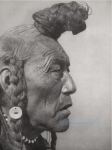(This is a
reprint of an essay originally published on Andrea Downing's
blog.)
Native American
Slavery
by Alethea Williams
In sofar as the
taking of captives and reducing them to slaves was concerned the Apache
acquired this custom from the Spaniard or Mexican, and it is safe to say that
during the period of which I write there was not a settlement in the valley of
the Rio Grande that did not number among the inhabitants a large number of
Apache and Navajo Indian slaves.
—Ralph Emerson Twitchell, The Leading Facts of New Mexican History, Torch Press, 1917
 |
Photo of a
Blackfoot by Edward Curtis, with a hairstyle described in Naapiikoan Winter as
one worn by the character Saahkómaapi (Young Man), Beaver Bundle Man to the
Inuk’sik band of the Piikáni, and the band’s Dreamer.
|
The primary female character in my novel, Náápiikoan Winter, is abducted as a child and later traded into slavery. She is abducted by Apaches, sold by Utes, and enslaved by other tribes including the Piikáni. Was it true that Native Americans learned this practice from contact with the Spaniards, as the quotation that opens my book asserts?
Although it’s true Christopher
Columbus started an unholy tradition by enslaving over 500 Indians, an article
on the website Oxford Research
Encyclopedia: American History by Christina Snyder says, “The history of
American slavery began long before the first Africans arrived at Jamestown in
1619. Evidence from archaeology and oral tradition indicates that for hundreds,
perhaps thousands, of years prior, Native Americans had developed their own
forms of bondage.” Indians captured women and children to replace the up to 90%
of their people killed by war and diseases they had no defense against. In an
article for Slate, Rebecca Onion says
“Native types of enslavement were often about kinship, reproductive labor, and
diplomacy, rather than solely the extraction of agricultural or domestic labor.”
All Native tribes that I know of
were called “The People.” What this common nomenclature implies is that the
people of one’s tribe were People, and all others were something less. Captives
were outside society, but slaves were even further outside the social order. So
as a slave passed from tribe to tribe, my character Buffalo Stone Woman would
have had many instances of rejection and neglect. For most of her adult life,
she would not have been accepted by anyone as a true person, but a creature
somewhere on a level with a dog or other tamed animal.
There were ways to escape the
status of captive, enshrined in solemn ceremony, that could make of a mere
captive a real person by adoption or marriage. Slaves were of a different
nature, “distinguished by the extremity of their alienation from captors’
societies and the exploitation of their labor to enhance the social or material
life of the master,” according to Snyder. Slaves often had a lot of freedom to
come and go in the performance of their duties. And slavery wasn’t a hereditary
condition: children of Indian slaves were not themselves enslaved.
So in Náápiikoan Winter, when Buffalo Stone Woman finds a home at last
among the Piikáni at the base of the Rocky Mountains where although a slave she
has attained the status of a distant wife to the powerful Orator, she wants
never to have to leave this safe haven. She is tolerated, even accepted. She brings
to her new people her skills and her knowledge, which makes them, already
powerful, an even more potent force on the Plains.
 |
A photo of a
woman wearing an elk tooth dress, a sign of high regard. Lucy Crooked
Nose - Cheyenne - 1898 - forums.powwows.com
|
